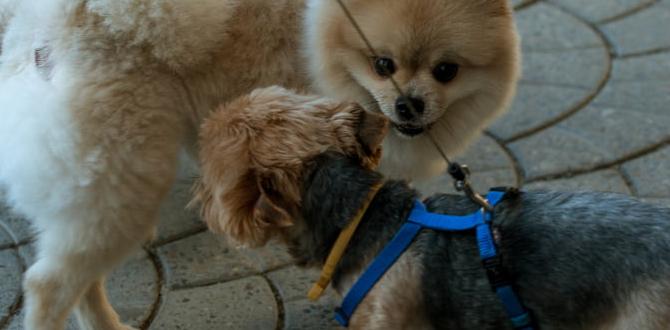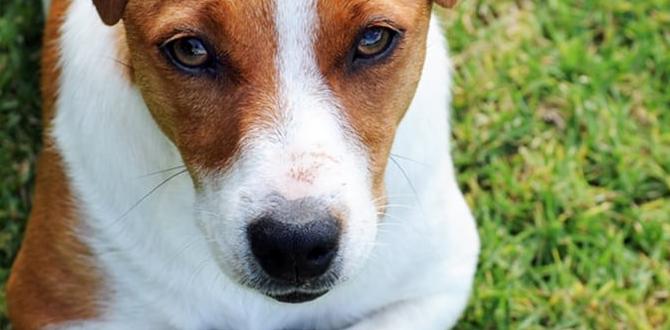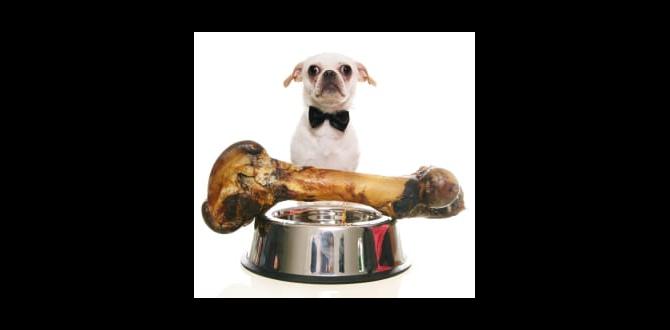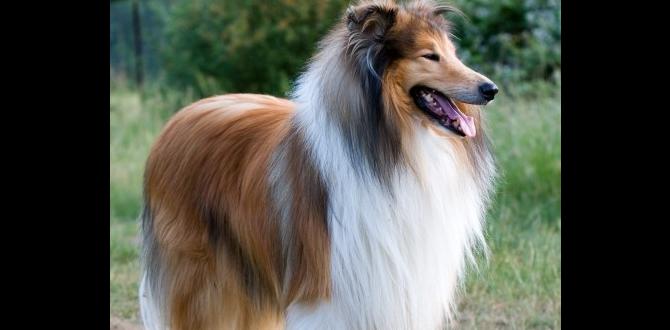Have you ever walked your dog and suddenly faced a barking, lunging pup? It can be scary. Many dog owners wonder how to handle a reactive dog in these tricky moments. Understanding your dog’s reactions is key.
Imagine strolling in the park. Your dog spots another dog and starts to bark and growl. You feel embarrassed and unsure. But what if you learned ways to turn these tough moments into positive experiences?
Handling a reactive dog isn’t just about avoiding problems. It’s about teaching them how to be calm and confident. It takes practice but can be done. Did you know that with the right techniques, you can help your dog feel better on walks?
This article will share tips and tricks on how to manage your furry friend in challenging situations. By the end, you’ll feel more confident in guiding your reactive dog. Let’s dive in and discover how to make your walks happier and more relaxed!
How To Handle A Reactive Dog: Tips For Calm Behaviors

How to Handle a Reactive Dog
Reactive dogs often react strongly to certain triggers like other dogs or loud noises. To manage this behavior, start by identifying their triggers. Reward calm behavior with treats or praise. Wouldn’t it be nice to walk your dog without fear of sudden outbursts? Start small with quiet environments and gradually introduce distractions. Consistency and patience are key. Remember, understanding your dog helps build a strong bond. With practice, both you and your dog can enjoy peaceful outings!Understanding Reactivity in Dogs
Definition of dog reactivity and common triggers. Signs and symptoms of a reactive dog.Reactivity in dogs means they respond strongly to things around them. This can be certain sounds, other dogs, or even people. Common triggers include:
- Other animals.
- Loud noises, like fireworks.
- Strangers or busy places.
Signs of a reactive dog may include barking, lunging, or growling. These behaviors often show fear or excitement. Understanding these signs helps you support your dog better.
What causes dog reactivity?
Dog reactivity is often caused by fear, anxiety, or lack of socialization. A dog may react strongly when they feel threatened or unsure. This can happen if they haven’t met many other dogs or people.
Identifying Your Dog’s Triggers
How to observe and document your dog’s reactive behaviors. Types of triggers (people, other dogs, sounds, etc.).Carefully watching your dog is essential. Note what makes them react. Keep a journal to track their behavior in different situations. Common triggers include:
- People: Strangers can cause excitement or fear.
- Other dogs: Some dogs may act aggressively when they see a new dog.
- Sounds: Loud noises like thunderstorms or fireworks are scary for many dogs.
Understanding these triggers helps you and your dog feel safer. With time, you can teach them how to stay calm around these things.
What triggers a dog to be reactive?
Triggers include unfamiliar people, other dogs, and loud sounds. Recognizing these can help you help your dog.
Behavior Modification Strategies
Techniques for redirecting your dog’s focus. Using commands to manage reactions during walks.Helping a reactive dog can feel like juggling. But don’t worry! You have tools to keep things cool. One fun way is to use commands like “look” to catch their attention. It’s like waving a magic wand! While walking, if your pup starts to react, a quick “sit” can make them calm down. Plus, using treats can turn a scary encounter into a tasty distraction. Who wouldn’t prefer snacks over stress?
| Technique | Description |
|---|---|
| Look | This command redirects their focus away from the trigger. |
| Sit | A great way to manage reactions during walks. |
| Reward | Treats help make scary moments less frightening! |
Creating a Safe Environment
Tips for dogproofing your home and yard. Controlled socialization opportunities.Dogproofing your home and yard is like setting up a fort for your furry friend. Start by removing things that could attract trouble, like trash cans and shoes. Use baby gates to manage spaces. This keeps your dog safe and sounds a lot easier than explaining why they chewed your favorite slippers!
| Tip | Description |
|---|---|
| Remove Hazards | Keep dangerous items out of reach, such as cleaning supplies and sharp tools. |
| Use Fencing | A strong fence works wonders in keeping your dog from exploring the neighbor’s garden. |
| Socialization | Arrange controlled meet-ups with calm dogs. Make sure your pup can practice good behavior! |
Creating small, controlled socialization chances helps your dog feel safer. Remember, practice makes perfect! And who knows? Your pup might end up being the life of the dog park party!
When to Seek Professional Help
Indicators that professional training is necessary. Types of professionals who can assist (trainers, behaviorists).If your dog shows serious signs of reactivity, it’s time to seek help. Some signs to watch for include:
- Frequent barking at strangers
- Growling or lunging
- Difficulty focusing during walks
- Problems with socializing
Professional trainers and animal behaviorists can provide support. Trainers focus on skills. Behaviorists deal with emotional challenges. Getting professional help can make big changes for your dog and your family.
When should I get help with my dog’s behavior?
If you see your dog acting aggressively or out of control, it’s good to get advice from a pro. A trained expert can guide you and your pet safely.
Long-term Management and Prevention
Establishing a consistent routine and training schedule. Importance of ongoing training and socialization for prevention.Creating a steady routine helps your furry friend feel safe and secure. Consistent training sessions build good habits and prevent unwanted reactions. Aim for short, fun training sessions, so your dog thinks learning is a game. Remember, socialization is key! Expose them to new places and friendly pets. This way, your reactive dog learns that the world isn’t so scary after all. As the dog whisperer might say, “A well-trained dog is a happy dog!”
| Tips for Routine | Benefits |
|---|---|
| Training daily | Builds trust and understanding |
| Social outings | Reduces fear and anxiety |
| Consistent commands | Prevents confusion |
Conclusion
In conclusion, handling a reactive dog takes patience and understanding. First, stay calm and identify triggers. Use positive reinforcement to reward good behavior. Practice training regularly and keep sessions short. Remember, progress takes time. For more tips, consider reading books or visiting training websites. With love and effort, you can help your dog feel safe and happy.FAQs
Sure! Here Are Five Related Questions On How To Handle A Reactive Dog:Sure! Here are five questions we can answer about how to handle a reactive dog: 1. **What does it mean if a dog is reactive?** A reactive dog may bark, growl, or lunge at other dogs or people. It could be scared, excited, or protective. 2. **How can I help my reactive dog stay calm?** You can help your dog stay calm by using treats and praise when they see another dog or person. This makes them feel safe. 3. **What should I do if my dog barks at other dogs?** If your dog barks at another dog, try to move them away from the situation. Find a quiet place to help them relax. 4. **Can training help my reactive dog?** Yes! Training can help your dog learn better behaviors. You can work with a trainer or use fun games at home. 5. **What should I avoid doing with my reactive dog?** Avoid yelling or pulling on the leash. This can make your dog more scared or upset. Stay calm and patient.
Sure! Please tell me the question you want me to answer, and I’ll be happy to help.
What Are The Common Triggers That Can Cause Reactivity In Dogs, And How Can I Identify Them?Common triggers that can make dogs react include loud noises, strangers, other pets, or sudden movements. You might notice your dog barking, growling, or pulling on the leash when they see these things. Watching how your dog behaves can help you figure out what bothers them. Keep a close eye on their body language, like wagging tails or tense muscles. This way, you can learn to protect them from things that scare or upset them.
What Training Techniques Can Help Me Manage My Reactive Dog’S Behavior Effectively?To help your reactive dog, we can try a few training techniques. Start with positive reinforcement. This means giving treats or praise when your dog behaves well. Next, use desensitization. This helps your dog get used to things that scare them slowly and safely. Lastly, practice basic commands like “sit” or “stay” to help them focus on you. Training takes time, so be patient and consistent!
How Can I Create A Safe And Calming Environment For My Reactive Dog During Walks Or Outings?To create a safe and calming place for your reactive dog during walks, you can plan ahead. Choose quiet routes with fewer people and other dogs. Keep a leash on your dog to stay close and safe. Bring treats to reward calm behavior. If your dog feels scared, take a break and let them relax.
What Steps Should I Take If My Reactive Dog Encounters Another Dog Or Person Unexpectedly?If your reactive dog sees another dog or person unexpectedly, stay calm. You can quietly move away from the situation. Use treats to distract your dog and keep their focus on you. If it’s safe, find a quiet space where your dog can relax. Always reward good behavior with praise or treats!
When Should I Consider Seeking Professional Help For My Reactive Dog’S Behavior, And What Should I Look For In A Trainer Or Behaviorist?You should think about getting help if your dog gets really scared or angry. If they keep barking or growling at people or other dogs, that’s a good sign. You want to look for a trainer or behaviorist who is nice and cares about dogs. They should use kind ways to train, not harsh methods. Ask them about their experience and if they’ve helped other dogs like yours before.
Meet Elyse Colburn, the devoted canine companion and storyteller behind the enchanting world of “Tales, Tails, and Adventures Unleashed.” A passionate dog enthusiast with a heart full of paw prints, Elyse Colburn shares heartwarming tales and insightful adventures, celebrating the joy, loyalty, and endless antics that make every dog a true hero. Join Elyse Colburn on this tail-wagging journey, where every post is a love letter to our four-legged friends.







